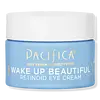What's inside
What's inside
 Key Ingredients
Key Ingredients

 Benefits
Benefits

 Concerns
Concerns

 Ingredients Side-by-side
Ingredients Side-by-side

Water
Skin ConditioningHelianthus Annuus Seed Oil
EmollientSorbitan Stearate
EmulsifyingCetearyl Alcohol
EmollientHydrogenated Lecithin
EmulsifyingBehenyl Alcohol
EmollientSqualane
EmollientCoconut Alkanes
EmollientHydroxypinacolone Retinoate
Skin ConditioningGanoderma Lucidum Extract
Skin ProtectingMelatonin
AntioxidantInonotus Obliquus Extract
Skin ConditioningGlycerin
HumectantRosmarinus Officinalis Leaf Extract
AntimicrobialChamomilla Recutita Flower Extract
MaskingAhnfeltiopsis Concinna Extract
Skin ConditioningCoco-Caprylate/Caprate
EmollientCetearyl Glucoside
EmulsifyingGlucose
HumectantSorbityl Laurate
EmulsifyingDimethyl Isosorbide
SolventPhenoxyethanol
PreservativeEthylhexylglycerin
Skin ConditioningWater, Helianthus Annuus Seed Oil, Sorbitan Stearate, Cetearyl Alcohol, Hydrogenated Lecithin, Behenyl Alcohol, Squalane, Coconut Alkanes, Hydroxypinacolone Retinoate, Ganoderma Lucidum Extract, Melatonin, Inonotus Obliquus Extract, Glycerin, Rosmarinus Officinalis Leaf Extract, Chamomilla Recutita Flower Extract, Ahnfeltiopsis Concinna Extract, Coco-Caprylate/Caprate, Cetearyl Glucoside, Glucose, Sorbityl Laurate, Dimethyl Isosorbide, Phenoxyethanol, Ethylhexylglycerin
Water
Skin ConditioningGlycerin
HumectantCyclopentasiloxane
EmollientPropanediol
SolventDimethiconol
EmollientCoco-Caprylate/Caprate
EmollientHydroxyethyl Acrylate/Sodium Acryloyldimethyl Taurate Copolymer
Emulsion StabilisingPhenoxyethanol
PreservativeMica
Cosmetic ColorantAcrylates/C10-30 Alkyl Acrylate Crosspolymer
Emulsion StabilisingCitrus Nobilis Peel Oil
MaskingSodium Benzoate
MaskingIsohexadecane
EmollientPolysorbate 60
EmulsifyingTriethoxycaprylylsilane
Maslinic Acid
AntioxidantCaprylic/Capric Triglyceride
MaskingSodium Hydroxide
BufferingHyaluronic Acid
HumectantRuby Powder
Skin ConditioningEthylhexylglycerin
Skin ConditioningAluminum Hydroxide
EmollientGlycine Soja Oil
EmollientGlucosyl Hesperidin
HumectantTocopheryl Acetate
AntioxidantRetinol
Skin ConditioningLecithin
EmollientLimonene
PerfumingCI 77891
Cosmetic ColorantCI 77491
Cosmetic ColorantWater, Glycerin, Cyclopentasiloxane, Propanediol, Dimethiconol, Coco-Caprylate/Caprate, Hydroxyethyl Acrylate/Sodium Acryloyldimethyl Taurate Copolymer, Phenoxyethanol, Mica, Acrylates/C10-30 Alkyl Acrylate Crosspolymer, Citrus Nobilis Peel Oil, Sodium Benzoate, Isohexadecane, Polysorbate 60, Triethoxycaprylylsilane, Maslinic Acid, Caprylic/Capric Triglyceride, Sodium Hydroxide, Hyaluronic Acid, Ruby Powder, Ethylhexylglycerin, Aluminum Hydroxide, Glycine Soja Oil, Glucosyl Hesperidin, Tocopheryl Acetate, Retinol, Lecithin, Limonene, CI 77891, CI 77491
Ingredients Explained
These ingredients are found in both products.
Ingredients higher up in an ingredient list are typically present in a larger amount.
Coco-Caprylate/Caprate is created from fatty coconut alcohol, caprylic acid, and capric acid.
It is a lightweight emollient. Emollients create a thin barrier on the skin to trap moisture in. This helps keep your skin hydrated and soft.
Once applied, Coco-Caprylate/Caprate is absorbed quickly and leaves a silky feel.
Coco-Caprylate/Caprate may not be fungal acne safe.
Learn more about Coco-Caprylate/CaprateEthylhexylglycerin (we can't pronounce this either) is commonly used as a preservative and skin softener. It is derived from glyceryl.
You might see Ethylhexylglycerin often paired with other preservatives such as phenoxyethanol. Ethylhexylglycerin has been found to increase the effectiveness of these other preservatives.
Glycerin is already naturally found in your skin. It helps moisturize and protect your skin.
A study from 2016 found glycerin to be more effective as a humectant than AHAs and hyaluronic acid.
As a humectant, it helps the skin stay hydrated by pulling moisture to your skin. The low molecular weight of glycerin allows it to pull moisture into the deeper layers of your skin.
Hydrated skin improves your skin barrier; Your skin barrier helps protect against irritants and bacteria.
Glycerin has also been found to have antimicrobial and antiviral properties. Due to these properties, glycerin is often used in wound and burn treatments.
In cosmetics, glycerin is usually derived from plants such as soybean or palm. However, it can also be sourced from animals, such as tallow or animal fat.
This ingredient is organic, colorless, odorless, and non-toxic.
Glycerin is the name for this ingredient in American English. British English uses Glycerol/Glycerine.
Learn more about GlycerinPhenoxyethanol is a preservative that has germicide, antimicrobial, and aromatic properties. Studies show that phenoxyethanol can prevent microbial growth. By itself, it has a scent that is similar to that of a rose.
It's often used in formulations along with Caprylyl Glycol to preserve the shelf life of products.
Water. It's the most common cosmetic ingredient of all. You'll usually see it at the top of ingredient lists, meaning that it makes up the largest part of the product.
So why is it so popular? Water most often acts as a solvent - this means that it helps dissolve other ingredients into the formulation.
You'll also recognize water as that liquid we all need to stay alive. If you see this, drink a glass of water. Stay hydrated!
Learn more about Water